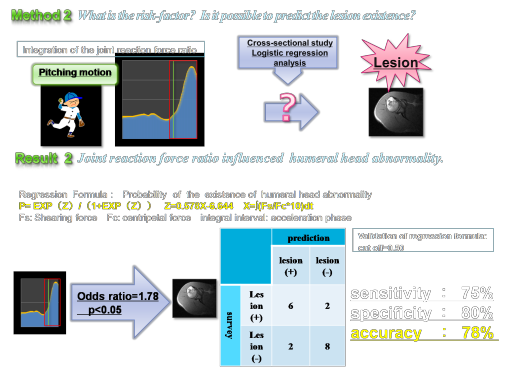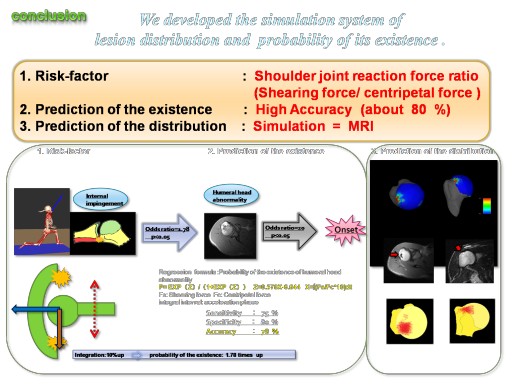@@@@@@@@@@@@@@@@@@@@@@@@@@@@@@@@@@@@@@@@@ 

Can you answer a kind of question below ?
[Doctor,If I change my pitching motion like
this,onft I suffer from throwing shoulder
injury ?]
This is one of the playerfs need at a
field.

We reported the shoulder MRI findings of 48
asymptomatic collegiate baseball players. They underwent conventional MRI at
asymptomatic phase.
As a
result, 52% of their humeral heads of throwing side had abnormal findings more
than the non-throwing side(11%).
The distribution and patterns of these findings
were similar to those which have been reported as throwing shoulder injuries in
symptomatic shoulders.
Then we investigated who got throwing
shoulder injuries after MRI for a year.
We did logistic regression analysis with MRI findings and the data of
the onset and found out the factors which significantly affected the onset.
As a result, the odds ratio of the humeral
head abnormality was 20. It means that the probability of the onset of throwing shoulder injuries with
humeral head abnormality is 20 times more than without it.
Humeral
head abnormality was thought to be the lesion which was near-related to the
onset.

The
purpose of this study is to predict the
lesion of the humeral head abnormality caused by internal impingement using the
pitching motion analysis.
In
order to develop the prediction system , we need clarify the following 3
issues.
1.
What is the risk-factors on dynamics of humeral head abnormality?
2.
Is it possible to predict the lesion existence of humeral head abnormality?
3.
Is it possible to predict the lesion distribution of humeral head abnormality? @
The
subjects were 18 asymptomatic collegiate baseball players who took part in both
MRI and pitching motion analysis. The shoulder joint reaction force was
calculated by multi-body dynamics analysis with musculoskeletal model. Then we
simulated the stress distribution in humeral head at maximum external rotation
(MER) of throwing phase using Finite Element Method analysis (FEM). Finally we
did logistic regression analysis to identify risk-factors on dynamics which
affected humeral head abnormality and we evaluated the validity of the lesion
distribution of this simulation using MRI.

We
put forward the following 2 hypothesis.
1. One of the risk-factors on dynamics of
humeral head abnormality is
the shoulder joint reaction force ratio.
we
defined the shoulder joint reaction force ratio as shearing force/centripetal
force.
2. Stress distribution in the simulation
which was consisted of the FEM model and joint reaction force was the
same as that
of humeral head
abnormality .

Research 1.
method 1:
We
constructed the musculoskeletal model . The musculoskeletal model is composed
of bones, joints and muscles. It is different from a link-segment model. In
this model, there are almost all muscles around shoulders. Each muscle-tendon
actuator has an active contractile element(CE) in parallel with a passive
elastic element. gΏh shows the pennation angle. These actuators contain
some mechanical properties (see above). We can customize these parameters
easily and can simulate variously.
We calculated the shoulder joint reaction
force ratio by multi-body dynamics analysis with musculoskeletal model and
compared the lesion(+) group with the lesion(-) group.
As a result, the shoulder reaction force
ratio of the lesion(+) group was significantly higher than that of the
lesion(-) group.

Research 2.
What is the risk-factor of the lesion
of humeral head abnormality. Is it possible to predict
the lesion existence?
Method 2:
We did logistic regression analysis with
the integration of the joint reaction force during the acceleration phase and MRI
findings of humeral head abnormality and found out the factors which
significantly affected the lesion. We also calculated regression formula which
could predict the probability of the existence of
the lesion
and evaluated the regression model.
As a result, the Odds ratio of η(Fs/Fc*10)dt
was 1.78. It means that the probability of the existence of humeral head
abnormality will increase 1.78 times, if the value of η(Fs/Fc*10)dt increases 10%. We could predict the lesion
with 78% accuracy.

Research 3.
We constructed Finite Element Method
analysis (FEM) model. In the FEM model , we extracted the shape of bones,
cartilages and labrums from CT and MRI. The shoulder joint reaction force was
calculated by using multi-body dynamics analysis with musculoskeletal model. We
input the force to the FEM model. We
simulated the stress distribution in humeral head at maximum external rotation
(MER) of throwing phase using FEM model. Then we evaluated the validity of the
simulation
by MRI findings of humeral head
abnormality.
As a result, stress distribution
in the simulation
was almost the
same as that
of humeral head
abnormality in MRI.


@
If you join the pitching motion capture and
use this system, you can know the lesion probability and distribution of the
humeral head abnormality of throwing shoulder injury.
Please input motion data (C3D format) to
this system, then the lesion distribution & probability of its existence are
output.
If there are some problems medically, you
can change motion data on a PC just like a game. ex) letfs move elbow down,
letfs flex elbow moreEEEEE
Please input motion data to this system and
simulate again, you can know the lesion probability and distribution of the new
motion.
If there is no problem, letfs challenge new
pitching motion at field. This system is the Computer Assisted Sports Science.

We developed the simulation system of the
lesion distribution and the probability of the existence of humeral head
abnormality caused by internal impingement of throwing shoulder injury.
One
of the risk-factors of humeral head abnormality on dynamics was the shoulder
joint reaction force ratio (shearing force/centripetal force) at acceleration
phase.
We calculated regression formula using the
shoulder joint reaction force ratio
and we could predict
the existence of humeral head
abnormality with 78% accuracy.
Humeral head abnormality was thought to be
the lesion which was near-related to the onset of throwing shoulder injury.
We simulated the stress distribution in
humeral head at MER using FEM model input the shoulder reaction force. Stress
distribution in the simulation was almost same as that of humeral head
abnormality in MRI. This simulation system was
expected to be the useful predictor of the humeral head abnormality.
 @@@@ @@@@ @@@@ @@@@
|